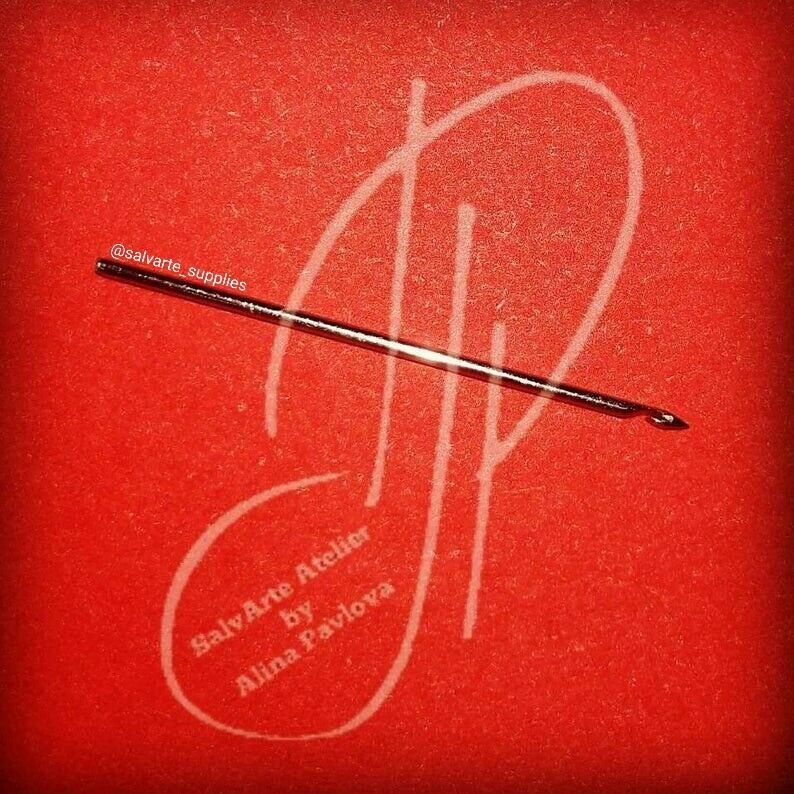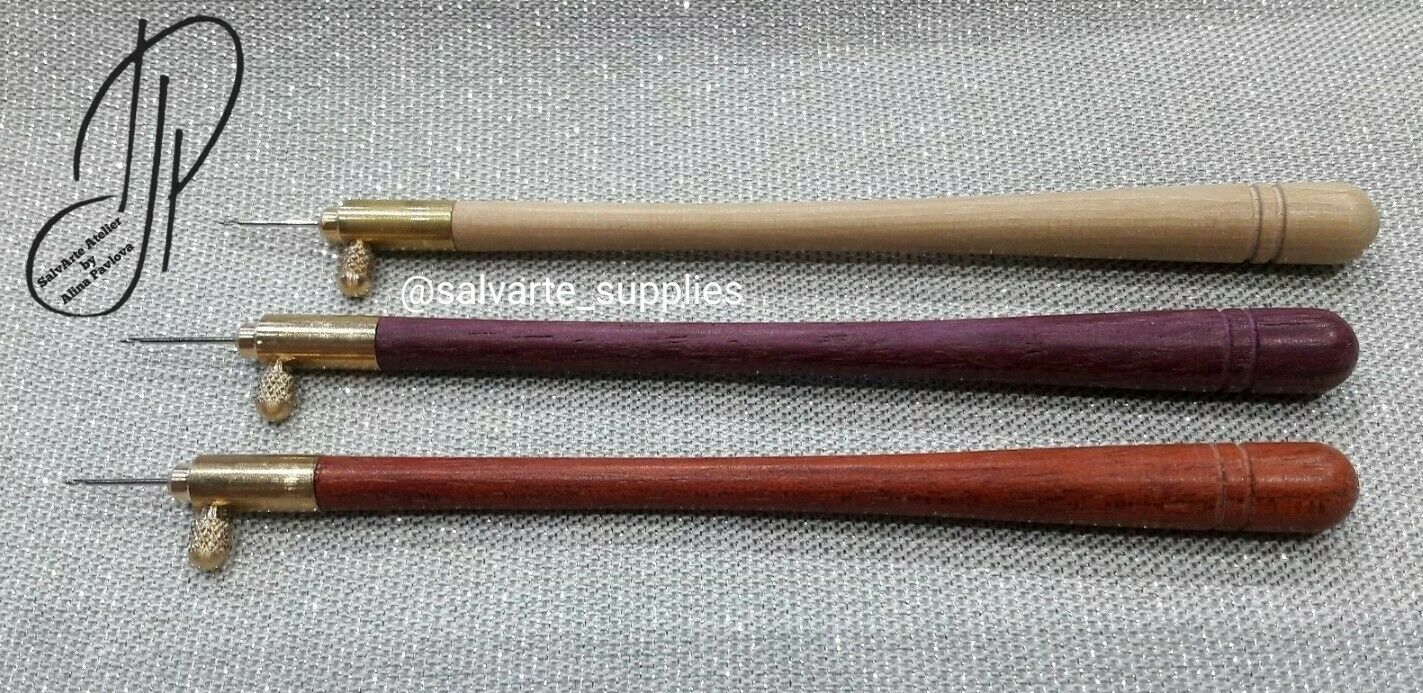-40%
French Luneville Hook Tambour Beading Lesage Embroidery Needle Crochet Aari Ari
$ 18.48
- Description
- Size Guide
Description
Original French Luneville Hook / Crochet de Lunéville / 70 / 80 / 90Aari / Tambour / Lesage Embroidery Hook / Crochet / Needle
Wooden handle - Made in France
The highest quality needles used in France.
Type of hook:
Luneville Hook (French) - an embroidery hook used specifically for the broderie perlée et pailletée of Luneville embroidery (Needle size 80 - the most common fine needle size), as well as golden work.. any of tambour embroidery / Beading / Couture Artwork
4 colors are available in the following variations:
1. Beige (Included: handle + needle Nr.80)
2. Purple (Included: handle + needle Nr.80)
3. Brown (Included: handle + needle Nr.80)
4. Dark Brown (Included: handle + needle Nr.80)
High quality and classic design.
Please note that the items are handmade, each hook can slightly vary in color and size.
The current product can be used for both Luneville (French) and Aari / Zardosi (Indian) embroidery technique.
For original Indian Aari needles please check other of our listings.
-----------------------------------------------------------------------
Broderie de Lunéville
Luneville embroidery is an umbrella term for various types of tambour embroidery, originating from the French town of Lunéville (Lorraine, France), where in the late eighteenth century a number of embroiderers had settled. Around 1810 they invented a form of tambour embroidery, using a very fine tulle cloth that was decorated with chain stitch. Luneville embroidery may thus be classed as a form of embroidered net lace.
By 1865 a local embroiderer called Louis-Bonnechaux Ferry started to add beads and sequins onto his work (broderie perlée et pailletée), still using a tambour hook (in this case nemed the crochet de Lunéville). The innovation caused a boom in Luneville work, as French fashion required more and more heavily beaded garments and trimmings. This trend quickly spread to other parts of Europe (compare Lier lace). The First and Second World Wars of the twentieth century, plus a change in fashion, led to a decline in the popularity of Luneville embroidery and many embroidery companies vanished.
The economic changes in the 1950's brought new opportunities, as beaded bags became popular again. In the latter half of the twentieth century beaded haute couture garments became fashionable and many of these creations were and continued to be made in Lunéville.
Aari Embroidery
Exquisite needlework of repeated fine chain stitches, worked in multi-coloured silk on a satin or cotton ground, is a timeless craftsmanship of 12th Century India. Flourishing in the states of Gujarat and Sindh under the patronage of the Mughal court, it is a series of unbroken stitches that take the shape of abstract nature and wildlife motifs. The uniqueness of the ”Aar” holed needle that is used to create these stitches, gave the name of what is known as Aari Embroidery.
Its original essence is from Barabanki, Uttar Pradesh. Aari embroidery was first seen practised by the mochi (cobbler) community, they worked with a hook-like needle without any pre-decided design or drawing and conceptualized the designs as they worked on leather. The mochi left their caste trade and became embroiderers for the Mughal Empire. Hence this style of embroidery is also known as Mochi Embroidery.
What is interesting about the Aari is that it is a style that has surpassed change. The art form had so much success that it was not only produced professionally for court use, but it gradually took over the commodity market and also at amateur level became part of folk or tribal tradition. The method of aari work however, varies from state to state.
Coloured thread is applied to make the designs and motifs highly representational.This technique creates precise definition from a fine regular chain stitch contributing a delicacy to the silk on silk embroidery. The method requires a hook needle plied from the top, but fed by silk thread from below, with the material spread out on a frame. This movement creates loops and is repeated, leading to a line of chain stitches.
During the late 18th Century, the Portuguese had taken the Aari to the West. The technique, alongside beaded embroidery, began appearing in couture fashion houses, where it took the name of Tambour Embroidery. Tambour, meaning drum in French, draws a parallel to stretching the fabric like a drum. While aari is an Eastern term and uses a very fine hook needle, the tambour is a western term for the hook that is placed into an interchangeable wooden holder. Although the end result of chain stitching is almost identical, the method used for beading is different.
In Tambour, the beads are loaded onto the thread first. Guides are applied only to the reverse, as the embroidery is worked wrong side up. This makes the stitching very quick, avoiding any unnecessary pausing, as a continuous thread is used until the embroidery is complete. In Aari the beads are loaded onto the hook itself. Loading up as many as required onto the hook, releasing the thread, reloading the hook and again. This process can be worked from the right side of the fabric.
Aari embroidery is of exuding beauty for the beholder and aesthetic elegance of the creator. Intricate chain stitches flow in the most poetic fashion, to form complex to simple patterns. The paint-like qualities of the medium are significantly favoured and admired by all, in the world.
------------------------------------------------------------------------------------------------------------------------------------------------------------------------------------------
If you are interested in bespoke apparel items / unique designs / handmade clothes and accessories... Follow us:
Instagram: @SalvArte_Atelier / @salvarte_supplies
Facebook: Raqs Sharqi Boutique
SalvArte Atelier
WhatsApp / Viber / GSM: +37127736261
Do not hesitate to contact us for any questions.


















